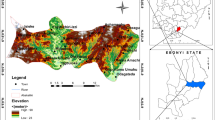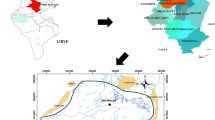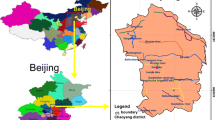Abstract
Groundwater vulnerability is an ardent problem all over the globe owing to the degradation of groundwater level and rising pollution which presents grievous adverse threat to the ecosystem. To determine this threat, comprehensive research has been conducted to examine the groundwater vulnerability by using several approaches. Broadly, the process-based approach, statistical analysis, and overlay index approaches are utilized in this regard. SINTACS method is one type of process-based and overlay index methods for vulnerability appraisal. This research represents a SINTACS model using applications of the Geographic Information System (GIS) techniques for groundwater vulnerability appraisal. According to the present SINTACS model, the study area surrounded high, moderate, and low zones of potential contamination with area occupy 20.41%, 71.6%, and 7.99%, respectively. The high potential contamination is majorly impacted by combined contributions of thematic layers viz., impact of the vadose zone, aquifer media, topography and net recharge. Nitrate concentrations analysis in some selected boreholes were compared with the SINTACS model to examine its accuracy. The validation rate of the present SINTACS model attains more than 65%, which is an evidence of a satisfactory modeling method. The SINTACS approach demonstrated its versatility even in this complicated hydrogeological setting.












Similar content being viewed by others
References
Abdelmadjid B, Omar S (2013) Assessment of groundwater pollution by nitrates using intrinsic vulnerability methods: a case study of the Nil valley groundwater (Jijel, North-East Ageria). Afri J Environ Sci Tech 7(10):949–960
Ahmed I, Nazzal Y, Zaidi F (2018) Groundwater pollution risk mapping using modified DRASTIC model in parts of Hail region of Saudi Arabia. Environ Eng Res 23(1):84–91. https://doi.org/10.4491/eer.2017.072
Al Adamat RAN, Foster IDL, Baban SNJ (2003) Groundwater vulnerability and risk mapping for the Basaltic aquifer of the Azraq basin of Jordan using GIS, Remote sensing and DRASTIC. Appl Geogr 23:303–324
Aller L, Bennet T, Lehr JH, Petty RJ (2004) DRASTIC: a standardized system for evaluating groundwater pollution potential using hydrogeologic settings. U.S. Environmental Protection Agency: Washington, EPA/600/2-85/018.
Almasri MN (2007) Nitrate contamination of groundwater: a conceptual management framework. Environ Impact Assess Rev 27(3):220–242
Al-Qurnawi WS, Al-Abadi AMA, Al-Malla IAR, Al-Badran AB (2019) A GIS-based SINTACS model for assessing intrinsic groundwater vulnerability of the Alton Kopri basin, Kirkuk governorate northeast of Iraq. J Phys Conf Ser 1294:082004
Al-Salamah IS, Ghazaw YM, Ghumman AR (2011) Groundwater modeling of Saq Aquifer Buraydah Al Qassim for better water management strategies. Environ Monit Assess 173:851–860
Anane M, Abidi B, Lachaal F, Limam A, Jellali SS (2013) GIS-based DRASTIC, Pesticide DRASTIC and Susceptibility Index (SI): comparative study for evaluation of pollution potential in the Nabeul-Hammamet shallow aquifer, Tunisia. Hydrogeol J 21:715–731
Azubuike SE, Edet AE (2015) Vulnerability assessment of aquifers within the Oban Massif, South-Eastern Nigeria, using DRASTIC Method. Int J Sci Eng Res 6:1123–1135
Babiker IS, Mohamed MAA, Terao H, Kato K, Ohta K (2004) Assessment of groundwater contamination by nitrate leaching from intensive vegetable cultivation using geographical information system. Environ Int 29(8):1009–1017
Bazimenyera D, Zhnoghua T (2008) A GIS based DRASTIC model for assessing groundwater vulnerability in shallow aquifer in Hangzhou-Jiaxing-Huzhou Plain. China. Med Well Res J Appl Sci 8(3):550–559
Buczko U, Kuchenbuch RO, Lennartz B (2010) Assessment of the predictive quality of simple indicator approaches for nitrate leaching from agricultural fields. J Environ Manag 91:1305–1315
Chroeder JJ, Scholefield D, Cabral F, Hofman G (2004) The effect of nutrient losses from agriculture on ground and surface water quality: the position of science in developing indicators for regulation. Environ Sci Pol 7:15–23
Civita M, De Maio M (2000) SINTACS R5, a new parametric system for the assessment and automating mapping of groundwater vulnerability to contamination. Pitagora Editor, Bologna, p 226
Civita M, De Miao M (2004) Assessing and mapping groundwater vulnerability to contamination: the Italian combined approach. Geofis Int 43:513–532
Clesceri LS, Greenberg AE, Eaton AD (1998) Standard methods for the examination of water and wastewater, 20th edn. American Public Health Association, Washington
Corniello A, Ducci D, Monti GM (2004) Aquifer pollution vulnerability in the Sorrento peninsula, southern Italy, evaluated by SINTACS method. Geofis Int 43(4):575–581
COST (European cooperation in science and technology) (2003) Action 620—vulnerability and risk mapping for the protection of carbonate (karst) aquifers. European Commission, Directorate-General for Research, Report EUR 20912, Luxemburg.
Doerfliger N, Zwahlen F (1997) EPIK: a new method for outlining of protection areas in karstic environment. In: Gunay G, Jonshon AI (eds) in: International symposium and field seminar on karst waters and environmental impacts. Balkema, Rotterdam, Antalya, pp 117–123
Elisante E, Muzuka ANN (2016) Assessment of sources and transformation of nitrate in groundwater on the slopes of Mount Meru, Tanzania. Environ Earth Sci 75(3):1–15
Ezeh CC (2011) Geoelectrical studies for estimating aquifer hydraulic properties in Enugu state, Nigeria. Int J the Physical Sci 6(14):3319–3329
Fazelabdolabadi B, Golestan MH (2020) Towards Bayesian quantification of permeability in micro-scale porous structures—the database of micro networks. Hi-Tech Innova J 1(4):148–160. https://doi.org/10.28991/HIJ-2020-01-04-02
Fırat EA, Ersoy H, Gültekin F (2006) Nitrate, nitrite and ammonia contamination in groundwater: a case study from Gümüşhacıköy Plain, Turkey. Asian J Wat Environ Pollut 4(1):107–118
Goldscheider N, Klute M, Sturm S (2000) The PI method—a GIS-based approach to mapping groundwater vulnerability with special consideration of karst aquifers. Z Angew Geol 46(3):157–166
Houria B, Mahdi K, Zohra TF (2020) Hydrochemical characterisation of groundwater quality: Merdja Plain (Tebessa Town, Algeria). Civil Eng J 6(2):318–324. https://doi.org/10.28991/cej-2020-03091473
Hussain MR, Abed BS (2019) Simulation and assessment of groundwater for domestic and irrigation uses. Civil Eng J 5(9):1877–1892
Hussain MH, Singhal DC, Joshi H, Kumar S (2006) Assessment of groundwater vulnerability in a tropical alluvial interfluve, India. Bhu-Jal News J 21:31–43
Jarray H, Zammouri M, Ouessar M, Hamzaoui-Azaza F, Barbieri M, Zerrim A, Soler A, Yahyaoui H (2017) Groundwater vulnerability based on GIS approach: case study of Zeuss-Koutine aquifer, South-Eastern Tunisia. Geofis Int 56-2:157–172
Jiménez-Madrid A, Carrasco F, Martínez C, Gogu RC (2013) DRISTPI, a new groundwater vulnerability mapping method for use in karstic and non-karstic aquifers. Q J Eng Geol Hydrogeol 46:245–255
Kansoh R, Abd-El-Mooty M, Abd-El-Baky R (2020) Computing the water budget components for lakes by using meteorological data. Civil Eng J 6(7):1255–1265. https://doi.org/10.28991/cej-2020-03091545
Khemiri S, Khnissi A, Alaya MB, Saidi S, Zargouni F (2013) Using GIS for the comparison of intrinsic parametric methods assessment of groundwater vulnerability to pollution in scenarios of semi-arid climate. The Case of Foussana Groundwater in the Central of Tunisia. J Wat Resour Prot 5:835–845. https://doi.org/10.4236/jwarp.2013.58084
Khemmoudj K, Bendadouche H, Merabet S (2014) Assessment of the vulnerability of an aquifer by DRASTIC and SINTACS methods: aquifer of Bazer–Geult Zerga area (northeast Algeria). E3 J Environ Res Manag 5(9):0169–0179
Kuisi MA, El-Naqa A, Hammouri N (2006) Vulnerability mapping of shallow groundwater aquifer using SINTACS model in the Jordan Valley area, Jordan. Environ Geol 50:645–650
Kumar S, Thirumalaivasan D, Radhakrishnan N, Mathew S (2013) Groundwater vulnerability assessment using SINTACS model, Geomat. Nat Hazards Risk 4(4):339–354
Margat L (1968) Vulnerability des nappes d’eau souterraine a la pollution (groundwater vulnerability to pollution). Basesde la cartographie (Doc) BRGM 68 SGL 198 HYD, Orleans, France.
Nigerian Meteorological Nate and Daily Rainfall Record No. 4 (2016)
NSDWQ (2007) Nigerian standard for drinking water quality, Nigeria Industrial Standard. NIS 554. Standard Organization of Nigeria, Lagos, p 30
Nury SN, Zhu X, Cartwright I, Ailleres I (2009) Three-dimensional (3D) aquifer visualization for sustainable water management. Proceedings of the Environmental Research Event, Noosa
Panagopoulos G, Antonakos A, Lambrakis N (2005) Optimization of the DRASTIC method for groundwater vulnerability assessment via the use of simple statistical methods and GIS. Hydrogeol J 14:894–911
Rahman A (2008) A GIS based DRASTIC model for assessing groundwater vulnerability in shallow aquifer in Aligarh, India. Appl Geogr 28:32–53
Sener E, Sener S, Davraz A (2009) Assessment of aquifer vulnerability based on GIS and DRASTIC methods: a case study of the Senirkent-Uluborlu Basin (Isparta, Turkey). Hydrogeol J 17:2023–2035
Shrestha S, Semkuyu DJ, Pandey VP (2016) Assessment of groundwater vulnerability and risk to pollution in Kathmandu Valley. (Nepal). Sci Total Environ 556:23–35
Twarakavi NKC, Kaluarachchi JJ (2006) Sustainability of ground water quality considering land use changes and public health risks. J Environ Manag 81:405–419
Uma KO (2003) Hydrogeology of the perched aquifer systems in the hilly terrains of Nsukka town, Enugu State, Nigeria. Wat Resour J 14:85–92
Umar R, Ahmed I, Alam F (2009) Mapping groundwater vulnerable zones using modified DRASTIC approach of an alluvial aquifer in parts of Central Ganga Plain, Western Uttar Pradesh. J Geol Soc India 73:193–201
Van Stempvoort D, Evert L, Wassenaar L (1993) Aquifer vulnerability index: a GIS compactable method for groundwater vulnerability mapping. Can Water Resour J 18:25–37
Acknowledgements
The authors would like to thank Mrs. Onyeabor F. C. and Mr. Nwatarali R. N. of the Department of geology and mining, Enugu State University of Science and Technology, Agbani, for their collaboration and for available documents used for this research.
Author information
Authors and Affiliations
Corresponding author
Ethics declarations
Competing interests
The authors declare that they have no competing interests.
Additional information
Responsible Editor: Broder J. Merkel
Rights and permissions
About this article
Cite this article
Ikenna, I.S., Chinedu, E.E. & Chibuike, I.E. A SINTACS GIS-based method for assessing groundwater vulnerability in sedimentary aquifers, South-Eastern, Nigeria. Arab J Geosci 14, 733 (2021). https://doi.org/10.1007/s12517-021-07092-5
Received:
Accepted:
Published:
DOI: https://doi.org/10.1007/s12517-021-07092-5




